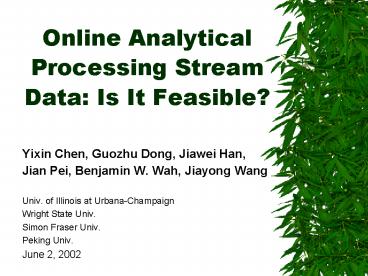Online Analytical Processing Stream Data: Is It Feasible - PowerPoint PPT Presentation
1 / 20
Title:
Online Analytical Processing Stream Data: Is It Feasible
Description:
Telecommunication: phone calls. Financial market: stock exchange ... Tradeoff for time/space between cube materialization and online query computation ... – PowerPoint PPT presentation
Number of Views:66
Avg rating:3.0/5.0
Title: Online Analytical Processing Stream Data: Is It Feasible
1
Online Analytical Processing Stream Data Is It
Feasible?
- Yixin Chen, Guozhu Dong, Jiawei Han, Jian Pei,
Benjamin W. Wah, Jiayong Wang - Univ. of Illinois at Urbana-Champaign
- Wright State Univ.
- Simon Fraser Univ.
- Peking Univ.
- June 2, 2002
2
Outline
- Characteristics of stream data
- Why on-line analytical processing and mining of
stream data? - A stream cube architecture
- Stream cube computation
- Discussion
- Conclusions
3
What Is a Data Stream?
- Data Stream
- Ordered sequence of points, x1,, xi, , xn, that
can be read only once or a small number of times
in a fixed order - Characteristics
- Huge volumes of data, possibly infinite
- Fast changing and requires fast response
- Data stream is more suited to our data processing
needs of today - Single linear scan algorithm can only have one
look - random access is expensive
- Store only the summary of the data seen thus far
- Most stream data are at pretty low-level or
multi-dimensional in nature, needs ML/MD
processing
4
Stream Data Applications
- Business credit card transactions
- Telecommunication phone calls
- Financial market stock exchange
- Engineering industrial processes power supply
- Monitoring surveillance video streams
- Web page click streams
5
Previous Research
- Stream data model
- STanford stREam datA Manager (STREAM)
- Data Stream Management System (DSMS)
- Stream query model
- Continuous Queries
- Sliding windows
- Stream data mining
- Clustering summarization (Guha, Motwani et al.)
- Correlation of data streams (Gehrke et al.)
- Classification of stream data (Domingos et al.)
6
Why Stream Cube and Stream OLAP?
- Most stream data are at pretty low-level or
multi-dimensional in nature needs ML/MD
processing - Analysis requirements
- Multi-dimensional trends and unusual patterns
- Capturing important changes at multi-dimensions/le
vels - Fast, real-time detection and response
- Comparing with data cube Similarity and
differences - Stream (data) cube or stream OLAP
- Is it feasible? How to implement it
efficiently?
7
An Example
- Analysis of Web click streams
- Raw data at low levels seconds, web page
addresses, user ip addresses, - Analysts want changes, trends, unusual patterns,
at reasonable levels of details - A typical data stream OLAP query
- Can we find patterns like
- Average web clicking traffic in North America on
sports in the last 15 minutes is 40 higher than
that in the last 24 hours.
8
A Stream Cube Architecture
- A tilt time frame
- Different time granularities
- second, minute, quarter, hour, day, week,
- Critical layers
- Minimum interest layer (m-layer)
- Observation layer (o-layer)
- User watches at o-layer and occasionally needs
to drill-down down to m-layer - Partial materialization of stream cubes
- Full materialization too space and time
consuming - No materialization slow response at query time
- Partial materialization what do you mean
partial?
9
A Tilt Time-Frame Model
Up to 7 days
Up to a year
10
Two Critical Layers in the Stream Cube
(, theme, quarter)
o-layer (observation)
(user-group, URL-group, minute)
m-layer (minimal interest)
(individual-user, URL, second)
(primitive) stream data layer
11
What Are the Issues?
- Materialization problem
- Only materialize cuboids of the critical layers?
- Popular path approach vs. exception cell approach
- Computation problem
- How to compute and store stream cubes
efficiently? - How to discover unusual cells and patterns
between the critical layer?
12
Stream Cube Structure from the m-layer to the
o-layer
(A1, , C1)
(A1, , C2)
(A1, , C2)
(A1, , C2)
(A2, B1, C1)
(A1, B1, C2)
(A1, B2, C1)
(A2, , C2)
(A2, B1, C2)
A2, B2, C1)
(A1, B2, C2)
(A2, B2, C2)
13
Stream Cube Computation
- Cube structure from m-layer to o-layer
- Three approaches
- All cuboids approach
- materializing all cells
- Exceptional cells approach
- materializing only exceptional cells
- Popular path approach
- computing and materializing cells only along a
popular path
14
An H-Cube Structure
root
Observation layer
politics
sports
enter.
uiuc
uic
uic
uiuc
Minimal int. layer
jeff
mary
jeff
mary
Q.I.
Q.I.
Q.I.
Quant-Info
Sum xxxx Cnt yyyy
Regression
15
Feasibility analysis
- Popular path
- Computing layers along the popular path
- Other planes/cells will be computed when
requested - Using H-cube structure to store computed cells
(which form the stream cube) - Tradeoff for time/space between cube
materialization and online query computation - Exception cells approach
- How to set up an appropriate thresholds for all
the applications?
16
a) Time vs. m-layer size
b) Space vs. m-layer size
Feasibility study Time and space vs. tuples at
the m-layer for dataset D3L3C10T400K
17
b) Space vs. levels
a) Time vs. levels
Time and space vs. of levels
18
Conclusions
- Stream data analysis
- Besides query and mining, stream cube and OLAP
are powerful tools for finding general and
unusual patterns - A multi-dimensional stream cube framework
- Tilt time frame
- Critical layers
- Popular path approach
- An important issues for further study
- Mining stream data at high-level,
multiple-levels, or in multiple dimensions
19
References
- A previous study on H-cubing
- J. Han, J. Pei, G. Dong, and K. Wang, Computing
Iceberg Data Cubes with Complex Measures,
SIGMOD2001 - A further study regression cubes and stream data
regression analysis - Y. Chen, G. Dong, J. Han, B. Wah J. Wang,
Multi-dimensional Regression Analysis of
Time-series Data Streams, VLDB 2002
20
www.cs.uiuc.edu/hanj
- Thank you !!!































